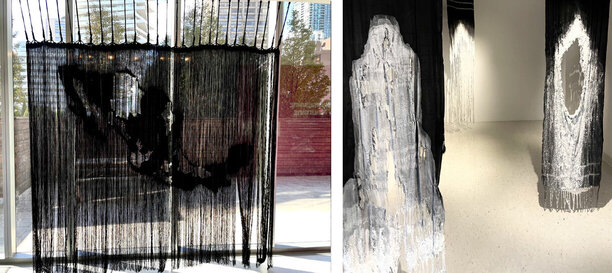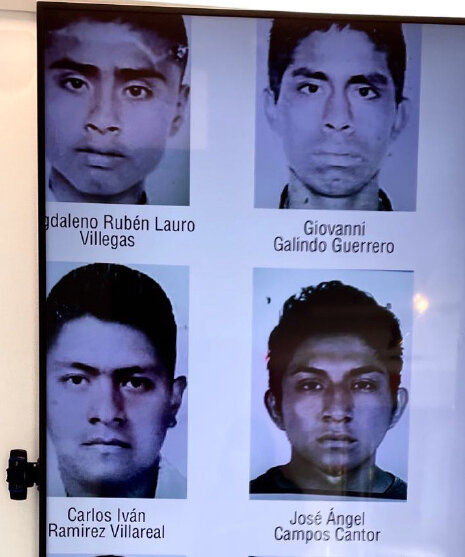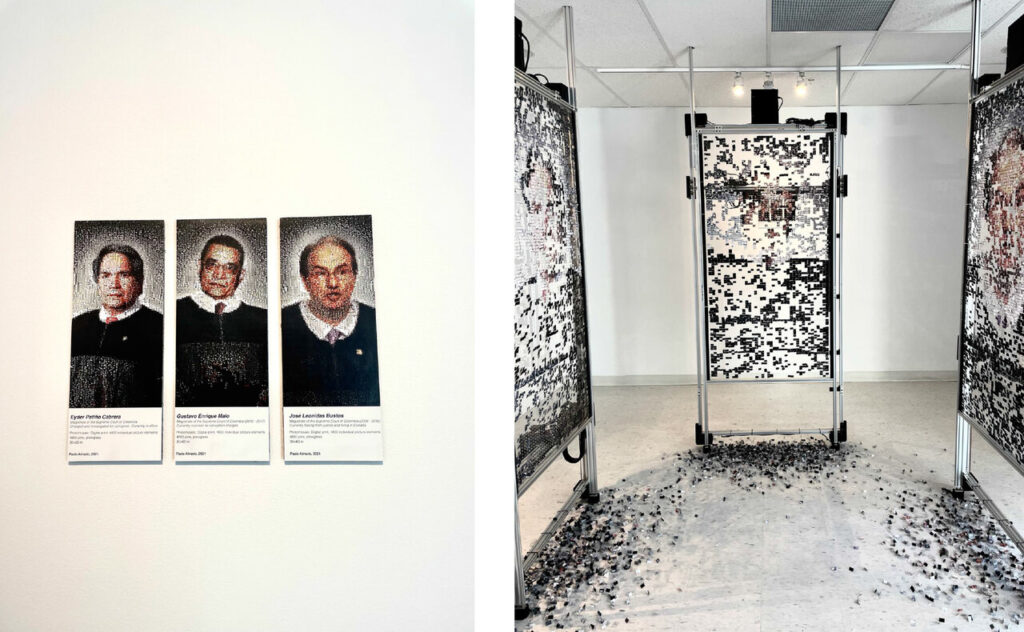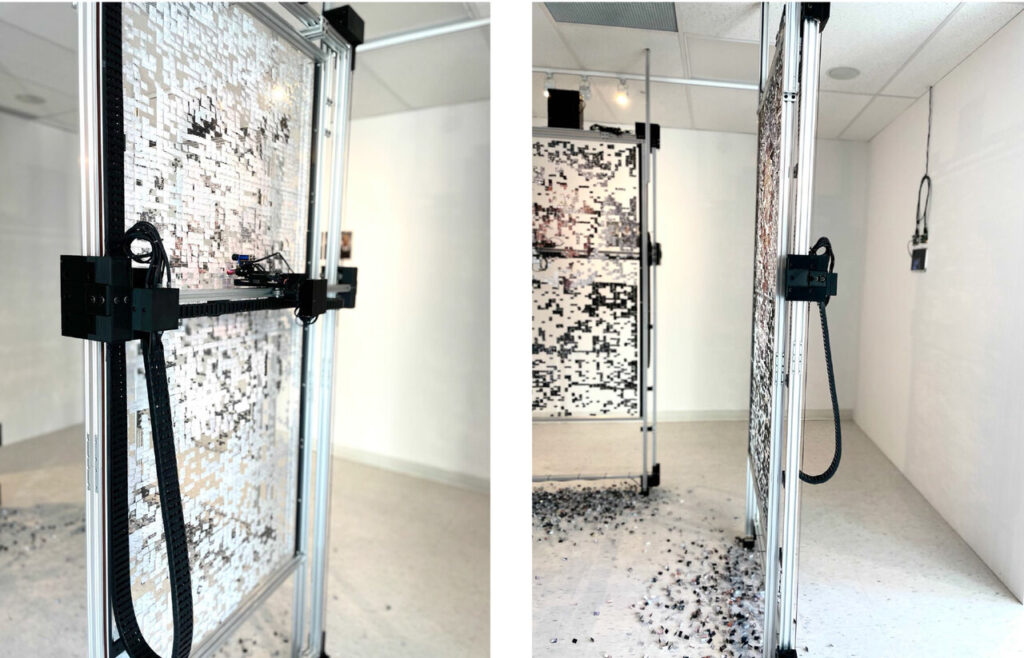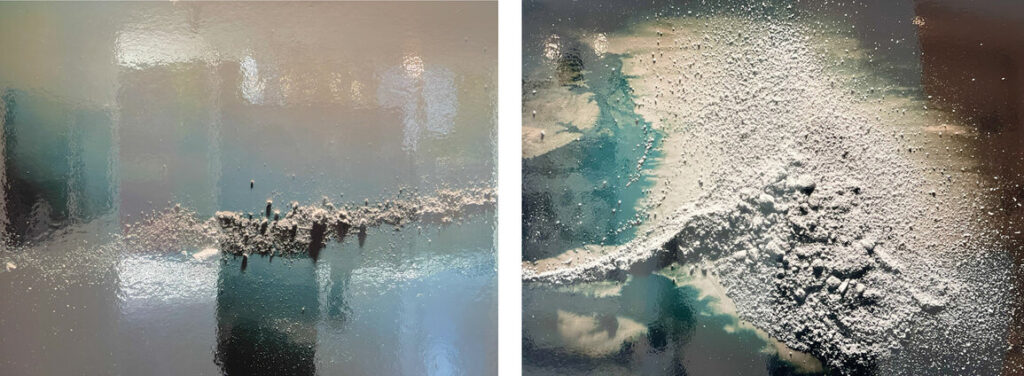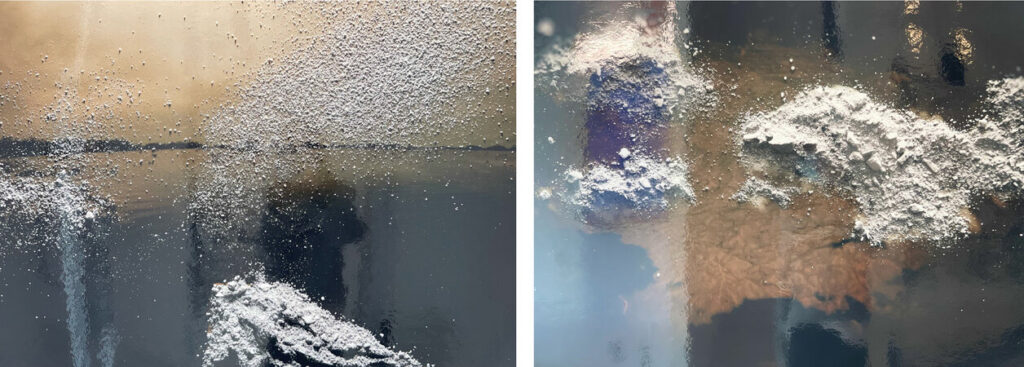During the COVID-19 pandemic, the act of mourning has been challenged. Thousands around the globe have not been able to be in the presence of sick friends, relatives, and loved ones. Reimagining Mourning at the Sur Gallery represents just this: the change of rituals, funerals, vigils, ceremonies, and congregations due to the pandemic. What’s presented is a powerful exhibition that explores new possibilities and perspectives about the human process of mourning. Through photographs and large multimedia installations, artists Paolo Almario, Laura Barrón, Claudia Chagoya, and Rafael Lozano-Hemmer, offer new insights into the way we mourn.
Claudia Chagoya is a Calgary-based artist. Working with textiles, she utilizes our sense of sight and smell to transport us into the grieving rituals of Mexico. Chagoya’s Unweaving foundations (2018) and Novem (2019) allude to the incitement of gender violence and femicide. The central motif of Unweaving Foundations is the “rebozo”, a shawl used from birth to death in Mexican culture. Chagoya unweaves the rebozo shawl piece by piece to create the map of Mexico. On her map, gaps highlight the highly populated areas where women are missing and murdered regularly — so it has become a portrait of the missing and the dead. An element of scent is also included in this piece. Laced with different herbs used to honor people on the day of the dead, the artist takes us into the tradition of commemorating and mourning.
In Novem, Chagoya uses the rebozo again but with the element of salt. The crystallized salt on the rebozos resembles bones, while the fibers of the shawl correspond to women’s hair — referencing the subjects and their decomposition. This powerful piece, clearly denounces the inexplicable acts on women’s bodies. To both cleanse, freeze, decompose and preserve, the component of salt is indispensable in the process of mourning.
Claudia Chagoya, Unweaving Foundations, unraveled rebozo 2018, 7 x 9 inches (left) & Novem, 2019, Installation composed of rayon rebozos and salt, 8 x 2 inches (right)
Mexican-born Montreal-based artist Rafael Lozano-Hemmer primarily works with mixed-media elements — he calls his works anti-monuments to pay tribute to missing persons in a nontraditional manner. Level of Confidence (2015) remembers the mass kidnapping of 43 students in a rural town in Mexico. Military and police forces were accused of being involved. As a form of irony, Lozano-Hemmer uses the same biometric surveillance algorithms as the police forces and tirelessly searches for the faces of the missing students. Level of Confidence is interactive. An individual can stand in front of the camera to activate the screen and, using artificial intelligence profiling, the algorithms find which student’s facial features look most similar to the viewer’s face—providing a “level of confidence” about how accurate the identification is. Of course, the “levels of confidence” will never be 100%. Lozano-Hemmer’s multi-media work is an ironic, heart-wrenching piece.
Rafael Lozano-Hemmer, Level of Confidence, 2015, Interactive installation, 64 inches in height, detail
Taking center stage at the Sur Gallery stands Chicoutimi-based artist Paolo Almario’s Réformé (2021). In a compelling and personal digital installation, Almario uses three automated, ephemeral, self-destructive panels that depict the portraits of the three magistrates who falsely accused his father and detained him as a political prisoner in Columbia. The portraits are made up of pixelated snapshots of Almario’s attacked home (by the Revolutionary Armed Forces of Colombia) and his father’s jail cell in which he spent nine years. In addition, the automated machine physically destroys the “pixelated” panels making the installation go beyond just the false accusations of his father to uncover a dark and corrupt system. Pieces of the panels line the gallery floors, representing Almario’s quest to have his father released from prison and his own process of mourning. One truly needs to see for him/herself just how striking this installation is.
Paolo Almario, Réformé, 2021, detail of the three magistrates (left) & Installation view (right)
Installation views of Paolo Almario, Réformé, 2021
Toronto-based artist Laura Barrón offers the photographic series, Palimpsest (2012). The title alludes to the nature of the subject, a sublime landscape covered with the ashes of the artist’s father. As a way to grieve and commemorate her late father, Laura Barrón imbeds her father’s ashes directly into her photographic practice and life’s work. She offers her way of mourning for a loved one inthis series, bringing together the living with the dead.
Laura Barrón, Landscape # 1, (left) & Landscape # 3, (right) both from the Palimpsest series, C-Type digital print, 50” x 33.3 inches
Laura Barrón, Landscape # 7, (left) & Landscape # 2, (right) both from the Palimpsest series, C-Type digital print, 50” x 33.3 inches
Reimagining Mourning at the Sur Gallery exhibits powerful, often very personal, works of art that offer a place for grieving and closure. Chagoya, Lozano-Hemmer, Almario, and Barrón capture spaces made for revisiting, reimagining, and remembering narratives of sudden loss while trying to overcome uncertainty and unpredictability in the present world.
Text and photo: Cathy Liu
*Exhibition information: Reimagining Mourning / Paolo Almario, Laura Barrón, Claudia Chagoya, and Rafael Lozano-Hemmer, September 30 – November 27, 2021, Sur Gallery, 100-39 Queens Quay East, Toronto. Gallery hours: Fri 12 – 6 pm, Sat 11 – 5 pm or by appointment.

